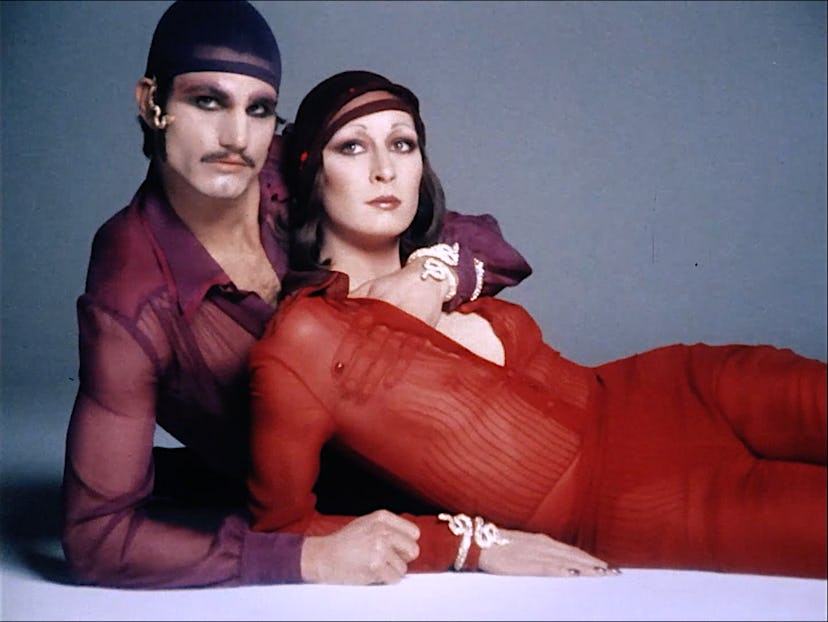Discovering Richard Avedon’s Intimate, Unseen Videos of ’70s Supermodels With Lauren Hutton

Before Richard Avedon became a legend of fashion and portrait photography, he came close to being a director, assisting on films like 1957’s Funny Face before he soured on the idea when Judy Garland got drunk on and ruined a live TV special that Avedon was directing.
But, as his Brooke Shields Calvin Klein ads attest, Avedon never fully abandoned that ambition. Only now is the full extent of his video work coming to light, in “Richard Avedon – Moving Image,” an exhibition featuring a dozen screens up at the Cadillac House in Manhattan until September 30 that showcase his up close and personal approach. There’s Catherine Deneuve discussing intimacy, Anjelica Huston reminiscing about her late mother, and Kate Moss staring straight into the camera — and those are just the private moments that made it into the ads.
The idea for the exhibition started, of all places, in a dressing room for Miley Cyrus at NBC Studios, when Visionaire‘s James Kaliardos and the makeup artist Oribe realized how many shoots they’d worked on with Avedon that had never been fully shown. So, with the help of Cecilia Dean, Visionaire’s cofounder, Kaliardos started digging through boxes at the Richard Avedon Foundation, finding not only the barely screened commercials, but a treasure trove of interviews by Avedon and his collaborator Doon Arbus in which they’re just getting to know Avedon’s subjects, before condensing their conversation into confessional shorts for brands like Chanel and Calvin Klein.
It’s a technique Dean knew something about: The first job she booked with Avedon when she was modeling in the 90’s started in his living room a few days earlier for tea. And while she worked with him for the last 10 years of his life, until Avedon’s death in 2004, practically all of the supers of the 70’s can attest to his knack for drawing them out: “He would think about everything way ahead of time to figure out how to get people in shots never seen of these very famous people that had been photographed thousands of times,” Lauren Hutton, who used to shoot with Avedon up to six times a week, recalled at the exhibition opening last night, as she reclined in a velvet dress into on one of the viewing cushions at the center of the gallery.
When Hutton was first starting out, for example, he asked her what her talents were. She told him she got quite good at jumping over logs as a kid, and he had her recreate that in his studio, launching one of fashion’s most iconic poses, and Hutton’s career. It’s one that’s on full display in his 1973 ad for the Japanese brand Jun Ropé, which until now had only been screened in Japan, and shows Hutton mid-air alongside Avedon himself, plus the model Pat Cleveland. “He was really good with jumping, and this was before they had fast-moving cameras so the whole camera crew would follow and run behind him with the umbrella for lighting,” Cleveland recalled, watching him run around on film and adding that that “feels like another planet at the moment.”
“He spent a lot of energy in everything he did,” Hutton added — to the point that when he saw her taking a nap in an unnaturally posed position on set, he started peppering her with questions about her why she slept that way. Eventually he got Hutton to reveal that she’d always hoped her father, who had been away in World War II, would take her away while she was sleeping if she looked like the pin-up girls on the covers of the magazine he worked on. “I wanted to look like one of those girls so he’d want to take me away, and Dick found it out,” Hutton said earnestly. “He was that kind of smart.”
Indeed, even in his commercial work, Avedon could get so personal that Dean and Kaliardos felt a responsibility to reach out to each subject in the films they’d chosen to make sure they’d be okay with its display. (Only a few declined.) Jamie King, for one, okayed her CKbe commercial discussing her friend’s suicide, but told Kaliardos she didn’t want to see it. “It represents a time in her life that she may not want to go back to,” Kaliardos said. “It just proves how authentic they are.”